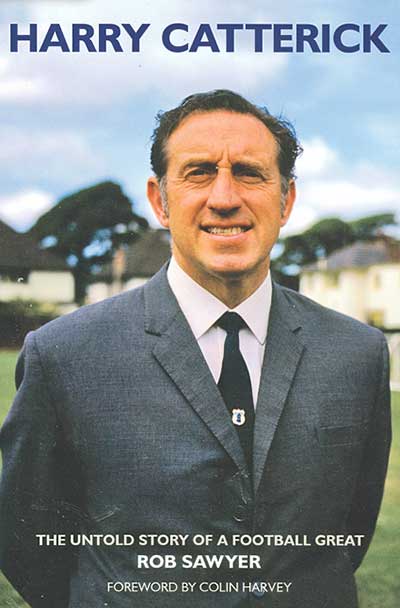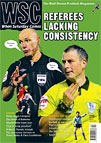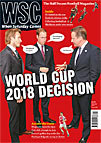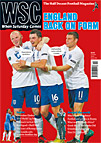Fresh from booting penny floaters into a nearby tree, magazine editor Andy Lyons, writer Harry Pearson and host Daniel Gray discuss players and managers who were only good at one club, from Mike Walker’s Norwich to Puskas’ Panathinaikos. WSC Deputy Editor Ffion Thomas tells us about magazine issue 430, Record Breakers brings a Bremen banger and we continue our sprightly feature, The Final Third, in which a guest contributes a match, a player and an object to the WSC Museum of Football. Joining Dan as our visiting curator this time is poet and Leeds United fan Matt Abbott.
Search: ' Panathinaikos'
Stories
 The untold story
of a football great
The untold story
of a football great
by Rob Sawyer
De Coubertin Books, £18.99
Reviewed by Simon Hart
From WSC 340 June 2015
It was 30 years ago in March that Harry Catterick died after suffering a heart attack at Everton’s FA Cup quarter-final against Ipswich Town. Five years earlier, Dixie Dean had also died at Goodison Park yet unlike the nationally famous striker, Catterick’s achievements – building two League title-winning teams – are today largely ignored beyond Merseyside.
Rob Sawyer has sought to redress the balance in a well-crafted biography that begins with a foreword from Colin Harvey, part of Catterick’s 1970 Championship side. “Don Revie, Bill Shankly, Bill Nicholson and Sir Matt Busby all get mentioned as being the great managers of the era while Harry doesn’t,” says Harvey of a man who won as many Leagues and FA Cups as Revie.
It is with Shankly, though, that Harvey makes the most telling comparison. For half of his 12-year reign, Catterick’s Everton drew the bigger crowds on Merseyside yet as Harvey recalls: “The press enjoyed being courted by Bill Shankly, but Harry was an introvert and snubbed them.” This is the crux of his image problem. Here was somebody who refused to allow the BBC cameras in to film Match of the Day until 1967 and had none of the charisma of his rival. Catterick was an aloof figure more akin to a modern-day director of football who – as his players would joke – put on a tracksuit only when the TV cameras or chairman John Moores appeared.
To achieve this insightful portrait, Sawyer pieced together interviews given by Catterick himself along with reminiscences of players and journalists and contemporary press cuttings. Alex Young recalls the coldness of a man not interested in courting popularity, saying: “I never got a pat on my head.” He had a devious side too, lying to the press and his own players; he told midfielder Brian Harris, for instance, that rumours of Tony Kay joining were false, only to swoop later that day for a player who had helped his Sheffield Wednesday side finish Division One runners-up in 1960-61.
Yet while his 1963 title-winners, built with the largesse of Littlewoods tycoon Moores, were dubbed “cheque-book champions”, the vision behind his youthful 1970 team would fit most current ideas of how to play the game. It was a 4-3-3 formation with the “holy trinity” of midfielders Howard Kendall, Harvey and Alan Ball at its heart. Dave Sexton, then Chelsea manager, applauded him for succeeding with a “set of small players up front” and Catterick’s own view was: “When it comes to the creation of something in tight corners, which midfield men have to do, give me the little ones.”
His players might have endured an old-fashioned factory-style clocking-in system but his planning of Everton’s Bellefield training ground – with an indoor pitch for small-sided matches – was another demonstration of foresight. Indeed in October 1970 Charles Buchan’s Football Monthly magazine dubbed the then 50-year-old “a manager for the Seventies”.
Sadly for Catterick – and his legacy – his Everton team soon fell apart. Sawyer recalls a pivotal week in March 1971 when they lost a European Cup quarter-final to Panathinaikos and FA Cup semi-final to Liverpool. After Ball left in controversial circumstances and Catterick himself suffered a heart attack, he was sacked in 1973. Not until 1985, two months after his death, would Everton win the League title again.
 Nassos Stylianou on how football, like every other sector of Greek society, has been demaged by the financial, political and social crisis
Nassos Stylianou on how football, like every other sector of Greek society, has been demaged by the financial, political and social crisis
After a chaotic summer for Greek football, the Super League filled its last two places seven games into the season. The delay was caused by an investigation in match-fixing, which resulted in Olympiakos Volou and Kavala being demoted to the fourth tier. The investigation, which concluded in June, lasted ten months and looked into 41 games from the 2009-10 season.
 Steve Wilson explains why the 21st century is causing increasing problems for those who enjoy collecting football shirts
Steve Wilson explains why the 21st century is causing increasing problems for those who enjoy collecting football shirts
Collecting football jerseys can be a challenging hobby. For starters, purchasing your own club’s kit can’t really be included as part of your indulgence, it is more of a duty. Consequently, with the seemingly now accepted trend of changing home and away tops every season, you can expect to dish out around £80 a term before you even begin budgeting for obscure polyester gems. The internet continues to be both a help and a hindrance. While the ability to buy pretty much any shirt from anywhere in the world is a nice option, the overwhelming choice somewhat dilutes the desire to spend excessive sums of holiday money on a jersey you could feasibly pick up online for less.
Case in point: a recent visit to Athens allowed me the perfect chance to get the Panathinaikos shirt that had eluded me previously, or so I thought. After seeing scores of fake jerseys on the streets of the Plaka district I finally came across a store selling official Pana tops. The price, however, equated to over £50. At that point I had to use some common sense and walk away.
In a matter of minutes online back home several options for the same jersey could be found for a more reasonable fee. But that is just not the same. To blithely pick off peculiar shirts from in front of your computer screen feels like cheating; for me they have to be legitimately collected on your travels.
There is another issue, though, when it comes to purchasing shirts abroad. Unless you want one of the top two or three clubs from the country you are in, then your time will likely be wasted trawling the shops. Furthermore, in a sign of the Premier League’s ever expanding dominance, it often appears simpler to buy a Man Utd, Liverpool or Arsenal shirt than it is to find local jerseys.
During the summer in South Africa it was easy to find the shirts of Johannesburg’s big two, Kaizer Chiefs and Orlando Pirates, but attempting to net jerseys of any other South African club proved more difficult. There was little variety to be seen, the hangers instead weighed down with the tops of England’s leading clubs.
Even at home this is an issue. As a youngster I recall one of the highlights of trips to other parts of the country was going to their sports shops and seeing unfamiliar shirts for sale. Nowadays, a branch of JJB in Aberdeen will likely have exactly the same stock as one in Plymouth. It seems most smaller British clubs don’t even bother trying to sell on the high street anymore, or are unable to, instead selling purely through the club shop or online store.
Sadly, a startling lack of creativity at times from the manufacturers also means that few modern shirts are desirable objects – helping the trade in second-hand retro strips in the process. Aside from the globally recognised brand clubs, the effort in coming up with a unique design seems to have largely disappeared – Nike, Adidas and Puma are happy to dish out template kits with only a change in colour and badge for those teams who are unlikely to sell outside of their own catchment area.
The flipside to that is when a club truly does do something different it stands out far more. France seems to be the current home for leftfield thinking, with Marseille’s recent light blue away shirt resembling a retired uncle’s Pringle golf jersey and Lyon’s away maillot looking like the kind of wallpaper you might find in a 1970s brothel. Both are inspired designs.
Ultimately, as with any collection, the continual growth leads to the quandary of where to keep your haul. With over 200 shirts, the dream of framing each individually became unrealistic a long time ago. At present, several plastic crates house my ageing relics while others are at the mercy of moths in the loft. Unlike the technological advances that will solve this issue for music, film and literary collectors of the future I cannot see a downloadable option providing a quick-fix solution for shirt collectors any time soon.
From WSC 287 January 2011
 Changing venues, vandalism and an intimidating empty stadium – Ken Gall tells the tale of a bizarre trip to Athens
Changing venues, vandalism and an intimidating empty stadium – Ken Gall tells the tale of a bizarre trip to Athens
For the many students of ancient Hellenic civilisation among the Dundee Utd travelling support, the news that United’s Europa League away leg at AEK Athens might have to be switched to a venue 186 miles away caused consternation for those whose main worry until then was how to combine a visit to the Parthenon with an evening’s entertainment at Piraeus’s alarming sounding nightspot, the Kinky Opera.